| Photo #1: the French Renault FT 17, A very early WW 1 tank and the genesis of the breed, whose intitial purpose was to defend against machine gun fire. By the look of it, it wasn't good for much else, but over 8,000 of them were produced. |
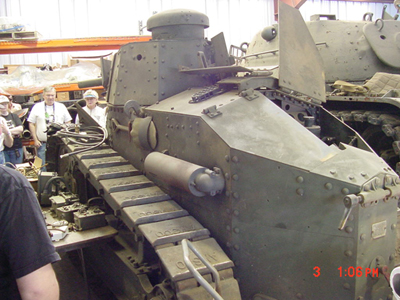 |
| Photo #2: Driver's station. Controls are those of a typical farm crawler tractor, from which the tank evolved. |
 |
| Photo #3: Before and After rebuilding; two identical engines, on the left: one painted and ready for installation. |
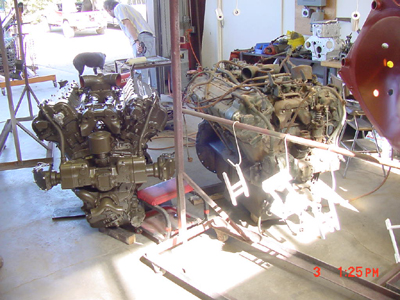 |
| Photo #4: This monster is called a Dragon Wagon; with an empty weight just 5 T below the legal civilian trucking limit. All wheel drive and capable of carrying a main battle tank. |
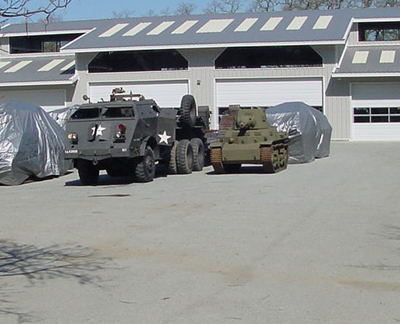 |
| Photo #5: Inside first building; there were two rows of machines in every one. Nestled cheek to jowl and with more to come, another warehouse was being built nearby. |
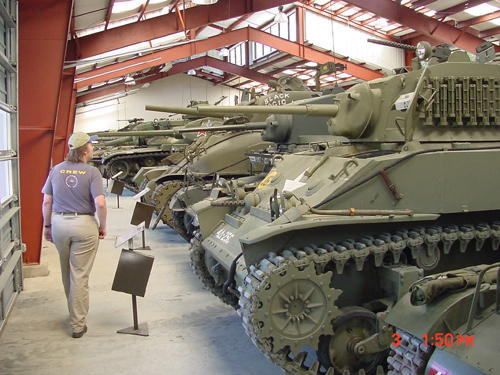 |
| Photo #6: Breech mechanism from a US M3 37mm AT gun on the M4 carriage; Made in USA, circa 1940. My personal favorite; what would it take, one wonders, to trundle this baby home?? |
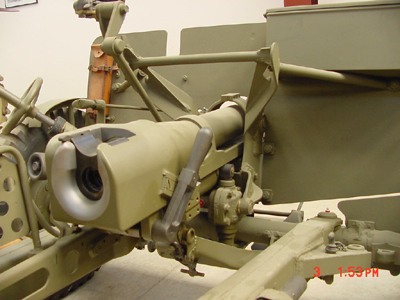 |
| Photo #7: Front view of the M3 37mm AT gun, arranged for towing. It turns out that the gun's capabilities were rapidly outclassed by the evolution of the armor this caliber was designed to defeat and it proved ineffective shortly after its introduction. |
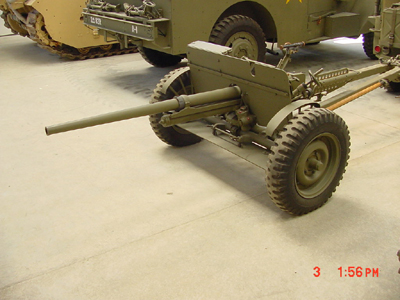 |
| Photo #8: Our guide and host, Jacques Littlefield (arm raised) points out a few details. |
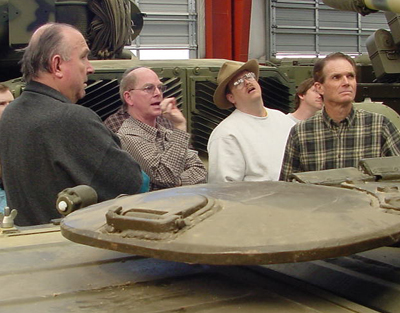 |
| Photo #9: The US M60A2 sports vision ports high on its turret in a "cupola", so that the commander can see in all directions while operating the .50 cal MG, which can be operated while the crew is buttoned up... It has the same 152 mm gun as the Sheridan M551. |
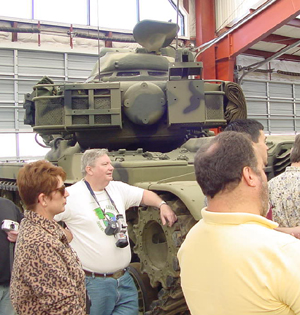 |
| Photo #10: Antiarcraft quad mount with great graphics. It says "Hose 'em down". |
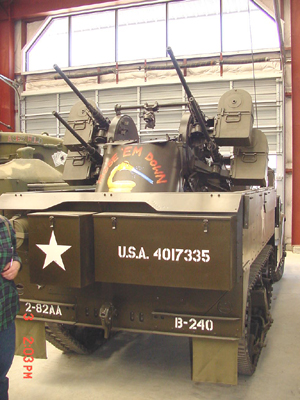 |
| Photo #11: Soviet T-72. Note the low profile of this tank; a characteristic of Soviet (and now Russian) armor; they seem to prefer the "hunker down" philosophy, providing a smaller shilhouette; no doubt an advantage in open terrain. Apparently examples of this model are quite common, now that the Iron Curtain has dropped and they are available at bargain prices, relatively speaking... |
 |
| Photo #12: This M551 Sheridan armor recon vehicle was one of the first to enter combat during the Gulf War, as it was light enough to be airlifted via C-141 or C-5 transports. Technically Deathstalker is not a "tank" as it only had welded aluminum plate armor. It was there first, more for intimidation value than anything else. Due to its light construction and short barrel one would think recoil made it a lousy shot, but I'm told it was accurate. Premature explosion of the caseless ammunition from incompletely burned products from the last explosion was a real problem; its stubby 152mm main weapon could also shoot the Shillelagh missile. It's heavy on defense, with many smoke launchers, to aid a hasty retreat... |
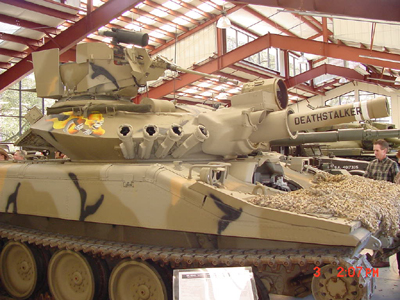 |
| Photo #13: This tank silhouette photo is a decoy, one of many that have been used very effectively over the years; including recent campaigns. |
 |
| Photo #14: 1/5 scale working model of a Soviet T-34/85 tank. Easy to fabricate he says, as innards are easy to procure, i.e. small Briggs and Stratton or similar gas engine, clutch from (??) rear end from (???) and so forth. This has rapidly become a hobby with many followers. |
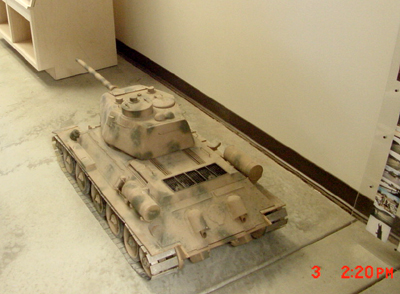 |
| Photo #15: Building #2 is a hall of machinery and spares; some intended for trade for things needed to complete one of their own projects. A large part of getting what is required to complete various projects seems to involve barter between museums and/or other collectors. |
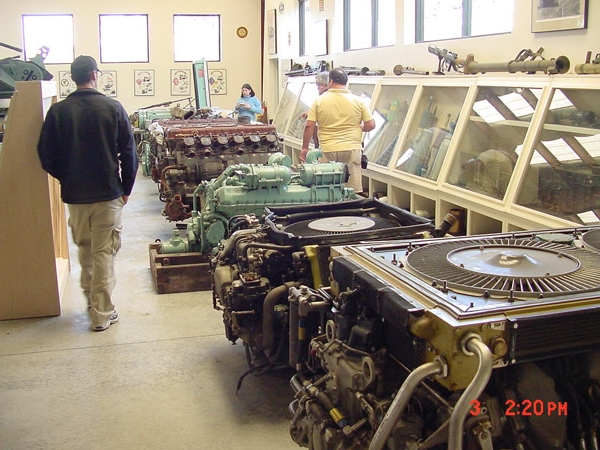 |
| Photo #16: A very large Soviet self propelled gun; 203mm (8in.) Note bulldozer blade on the back end; lowered and dug in to control recoil(?) |
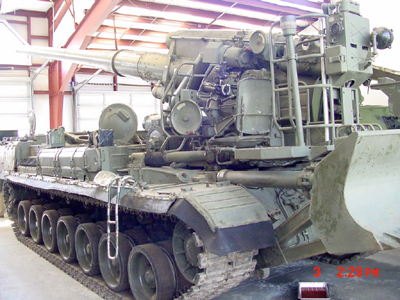 |
| Photo #17: Dwarfing the bridging machine in the background this Czec mobile radar control center was the largest machine indoors. The radar dish is something like 50ft wide and folds along top of vehicle for travel. This was one very large contraption, but the several control consoles still looked very cramped and uncomfortable. |
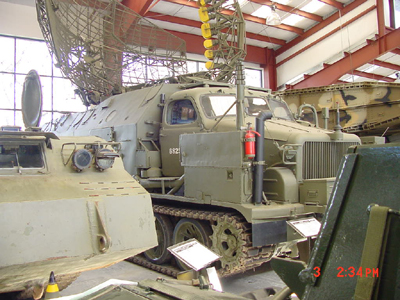 |
| Photo #18: 90mm tank gun, which Jacques used to demonstrate loading speed and cycle rates (very fast!). |
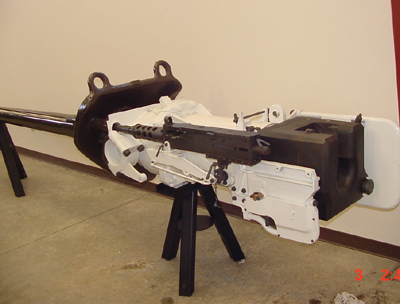 |
| Photo #19: Not available in too many used car lots: it's a Scud-A missile launcher; one of only one in private hands. This one was used for training purposes and the missile is a dummy. |
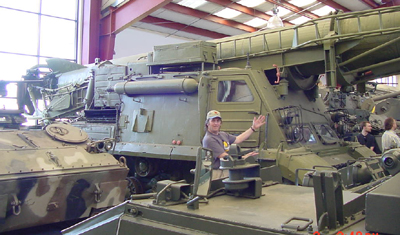 |
| Photo #20: The business end of the thing; Mr. Littlefield says the reason he could own the thing at all is because the technology is similar to that in a V-2, meaning that by today's standards it's primitive. Indeed, some high-powered model rockets may exceed its range, but it's nothing to sneeze at. Curiously US Customs didn't bat an eye until he tried to import a second one. Suddenly it's become a bit more complicated... |
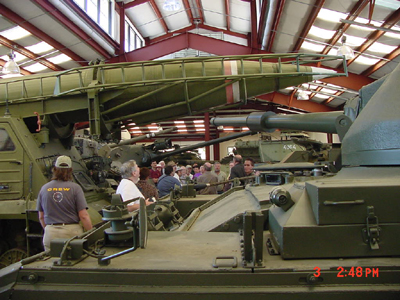 |
| Photo #21: The largest tank ever made: a British Conqueror which sports a 120mm gun. It was built to counter the Soviet JS-I, II and IIIs. |
 |
| Photo #22: Treads on the smallest British tank, the Scorpion. He said this is a good "starter" tank for the novice collector as there are lots of them about and it only weighs 7 tons, so it can be moved relatively easily. It also has a top speed of something like 40mph and is "...a real kick to drive!". Thinking Battlebot thoughts I particularly liked the treads, which had a wide footprint and simple construction. |
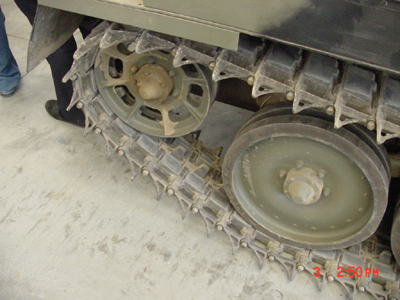 |
| Photo #23: Here's a new acquisition, a US M36 90mm GMC (Gun Mortar Carriage). This one came from the former Yugoslav Army (my, how things get around!). The spray paint indicates that it was running when he bought it. The "USA" means that it has been demilitarized to meet US import guidelines. "Running" means just that; there are only three recognized states; hulk being the worst and running being more typical. (Forgot what the third one is...) Once its time comes round, this tank will be restored to mint condition. |
 |
| Photo #24:This late 1943 or 1944 German Sturmgeschatz III G is almost finished. This design, with its 75mm gun, was responsible for more allied tank losses than any other; not so much because of its lethality (which was low compared to later models such as the Leopard or Panzer), but because of the high numbers of them that were made. This particular one "...was aquired from Finland, which had bought them from Germany in 1944 and used against the Soviets during their final summer offensive which knocked Finland out of the war." |
 |
| Photo #25: Close-up of treads on the Sturmgeschatz III G reveals one of the shortcuts used to assemble mass quantities. Note bent pins used to retain smooth link pins, instead of more typical nuts on threaded rods. One cannot but admire the simplicity of design. |
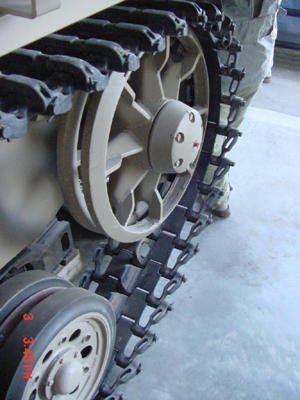 |
| Photo #26: For those who have wondered here I am at last, leaning against another recent acquisition. Note pot belly that casts its own shadow. More rebuilding ahead for the both of us it seems... |
 |